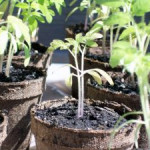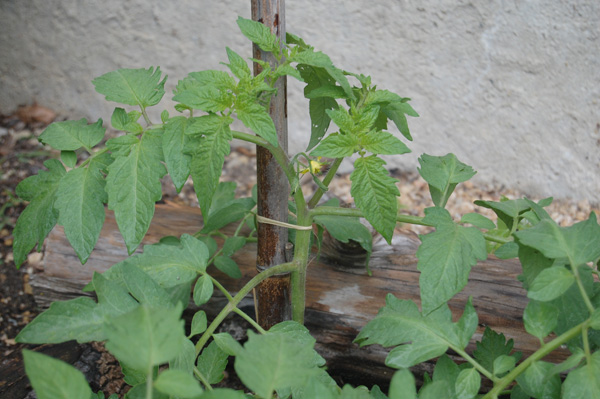 For growing tomatoes from seed you need to be thinking about sowing tomato seeds about 6 to 8 weeks before you expect the last frost of the year to occur or when you would like to be putting your plants into their final growing position.
For growing tomatoes from seed you need to be thinking about sowing tomato seeds about 6 to 8 weeks before you expect the last frost of the year to occur or when you would like to be putting your plants into their final growing position.
From a temperature perspective the best temperature range for sowing tomato seeds is between 15ºC and 25ºC (60ºF to 77ºF) you could probably get away with 10ºC (50ºF) overnight but you would need to cut back on the watering a little to take account of the lower temperatures.
Equipment
You can either purchase Seed Starting Trays and equipment or alternatively you can use items like yogurt pots or egg cartons to get your tomato seeds under way. If you already have pots or seed trays available and want to reuse them then make sure that you disinfect them first with a mix of 1 part bleach and 10 parts water to ensure that you remove any contamination.
There are a number of useful items that can be purchased specifically for growing tomatoes from seed, but you can provide a similar environment by simply using your initiative. For example placing a seed try in a clear plastic bag will give the same affect as using a seed tray with dome. It really is just up to you whether you want to purchase items for convenience or if you are happy to improvise some solutions yourself.
Sowing Tomato Seeds
If you have purchased seeds to plant then don’t forget to refer to the packet to get additional details on the best way to sow them according to the suppliers instructions. On the other hand for seed you may have collected yourself and as a general guide, seeds should be planted around 4 to 6mm (1/8″ to 1/4″) deep in a general purpose Potting Soil Mix Make sure you don’t overcrowd them, as a general rule if you are using a seed tray with multiple cells you should aim for around 2 seeds per cell and should slightly dampen the mix before pushing the seeds in. The easiest way of pushing the seeds in is to use a pencil or similar to poke them to the required depth.
Cover the tray (or pots) with plastic and leave the seeds to germinate, it is a good idea to label different varieties as they may grow at different rates. Also remember as seeds that they do not need fertiliser, just leave them as is.
Once the tiny plants appear, usually within 5 to 10 days you should place them in a position where they can get plenty of light, remembering that they are still indoors at this stage. If you have too many plants in a cell, select the strongest one to leave and snip the other off close to the soil surface with a pair of sharp scissors. Don’t be tempted to pull it out as this may disturb the roots of the one you want to keep.
Water very lightly at this point, for proper tomato plant care you should never over water at any stage, the plants should be moist but not drenched. For strong plants that are less brittle in the stem it is a good idea to brush the young plants lightly with your hand to flex them slightly once or twice a day.
When the plants are big enough to handle comfortably, usually when the first leaves are formed, you can transplant them to small pots around 3″ to 4″ diameter using a general purpose compost. Fill the pots half full and as the plants grow top them up periodically to encourage a healthy root system.
Now all you need to do is leave them until they are ready to transplant to their final planting position (about another 4 to 6 weeks), but of course watering them as required to keep the compost moist; as you would anyway for tomato plant care in general. If you think they need it you can give them a little bit of a boost with a suitable tomato feed. Although while they are relatively small there should be enough nutrients in the compost to keep them happy.



No doubt g- rowing tomatoes in a home garden is a popular past-time for millions of people around the world. Why?… because there is NOTHING like a fresh, ripe tomato from your very own garden.
I love tomato! thanks for this information… it really helps!
Hi, hope it helps you grow loads of tomatoes.